This is a post I originally wrote in 2013 and updated in 2015. Please note: the pool that I show is no longer on the market. I recommend the La Bassine or Birth Pool in a Box line of pools for their excellent quality, size, and affordability.
(Excuse my sideways photos. I’m having some WordPress trouble today).
One of the most common phone calls I receive for the business is parents wondering how to prepare for a home birth or a water birth. They take a look at the website, but are still confused about what to purchase, or don’t know what is really a necessity vs. just “nice to have”. After having two very different home water births of my own and attending many more as a doula, I would like to chime in. First I’ll start with a list and then go on to explain with photos.
Home Birth Essentials – this is really just about protecting your furniture/carpets/etc. – for suggested quantities, please see my commentary later in the post.
-disposable underpads
–painters plastic/waterproof paper sheets/plastic shower curtain
-heavy flow maxi pads (disposable or cloth)
-garbage bags
-zip-loc bags
-old towels and wash cloths (should be clean from the washing machine, but don’t require special sterilization)
-bowl or container for placenta
Home Birth “Should Haves” – helps with clean up and physical recovery
-mesh panties
-peri bottle
-hydrogen peroxide
–gauze or lap sponge
–epsom salts
–perineal healing herbs
-witch hazel
-arnica pellets
-sitz bath
Home Birth “Nice to Haves” – to make the experience more comfortable (your doula might carry some of these items)
-Emergen-C / Labour-aide / coconut water / honey sticks (quick energy)
–heat pack / hot water bottle
-TENS machine
-homeopathic kit
-rebozo
-Labour Link
-Aromatherapy items
-Accel Wipes
-quilted underpads
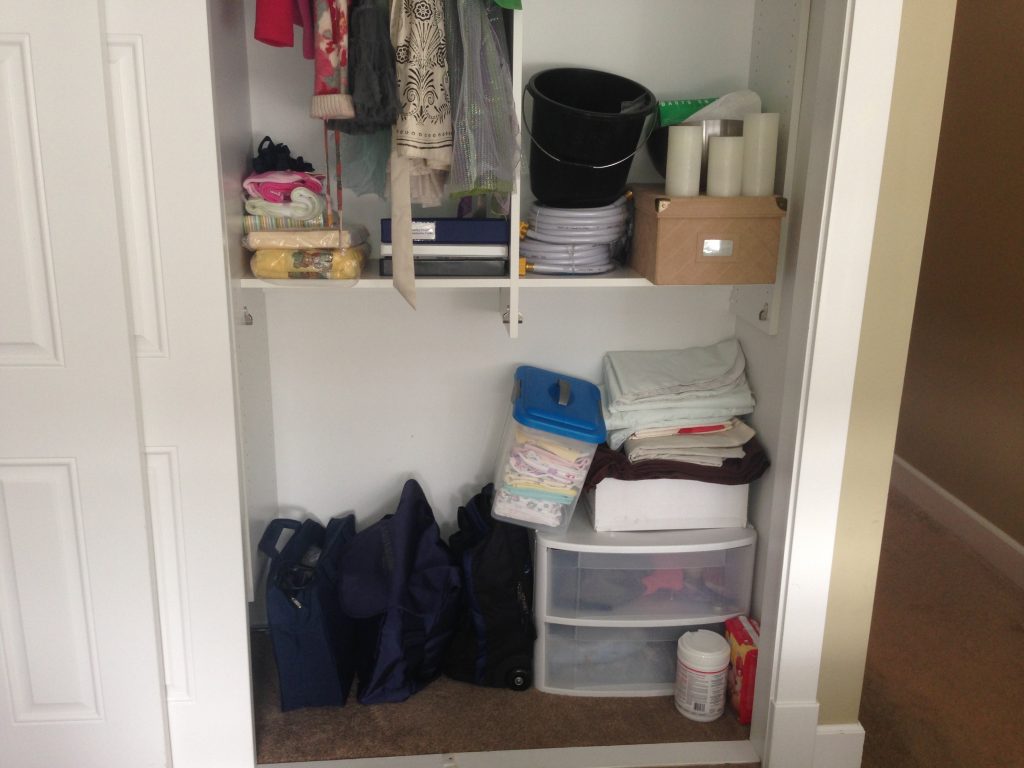
Ignoring the fact that my daughter’s clothes are still hung up in one quadrant of the closet, let me explain the other three:
Bottom Left: These are all my water birth supplies that I will go into more detail with later when I talk about pool set-ups.
Bottom Right:
Accel wipes:These are a birth bag essential if you’re a doula or midwife, as far as I’m concerned. They are a medical grade disinfectant, but since they’re really just accelerated hydrogen peroxide, they are gentle enough that you don’t even need gloves (the MSDS even says that!) and they don’t give off any nasty fumes. They’re gentle enough on vinyl to disinfect birth pools, strong enough to disinfect any hard surface, wipe down equipment, and even get blood out of the carpet and couch. A serious asset.
Newborn diapers: Either disposable or cloth, you’re gonna want some – or a dedicated bowl if you’re doing EC from day one.
Extra pool liners: We had some extra liners handy in case we wanted to do an herbal bath after the birth in fresh water. I didn’t feel in any shape to do that after Arden’s birth, but we did use one a few days later when Morag of Apple Blossom Families came over to do a “first bath” photo shoot for our family. This is a seriously fun idea.
Breastfeeding supplies: You don’t need these immediately on the scene at a home birth, but after having a challenging time breastfeeding my daughter, I wanted to be prepared and also have it some place handy. If you’re looking for a good source for breastfeeding supplies, check here.
Receiving blankets: The midwives will want to know where these are, as they lay some down on the warmer when they are setting up their resuscitation equipment. Also, you can never have too many receiving blankets.
Old bedding: Because we didn’t know when I would go into labour, we wanted to keep the old bedding clean for the big day.
Quilted underpads:These are great in general if you have small children. They are large and washable. I recommend having a few around. They are great for underneath you during birth, but also on your bed or couch in those first few days postpartum. They are also great for diaper changing, “no diaper” time, EC, toilet learning, or nighttime bed wetting.
Top right:
Clean bucket– this has multiple uses. Firstly it can be used to take a bit of cool water out of the pool if you need to warm the pool up. The submersible pump, unless you just bought one brand new, should never been considered clean enough for anything but the final drain. You also want to have this bucket handy after the final drain to pop the submersible pump into, as it will be dripping with birthy water.
2 hoses– some people use one to fill and one to drain. In my situation I used the same hose for both, but I wanted to use the pool again to bathe in clean water before it was taken down. Filling a pool with a hose that has been used to drain a pool before is just downright gross. I needed at second hose for the next use of the pool. If you are ever renting a pool and it comes with a hose, ensure that it’s a brand new hose. The danger with the “in-hose” and “out-hose” system is that sometimes people mix them up, and someones people leave the fill hose dangling in the water when the birth occurs or while there is “other” debris floating in the water.
Gloves– you can’t have too many of these. Birth can be a messy business, and gloves always come in handy. My 4 year old and I were sitting on the couch one day watching a birth DVD to help prepare her. When she watched a placenta being born on land, she didn’t flinch one bit but calmly asked “there will be gloves at the birth, right?”.
Large bowl– this is for the placenta at the end. While birth is happening though, you can fill it with cold water or ice and use it for keeping the cool facecloth cool. It’s also handy to have a large receptacle like that around in case the mom feels the need to throw up. Just sayin’.
Maternity Pads– these can also be left in the bathroom. In my situation though, I had too much junk on my bathroom counter as it was. There was more storage space in the closet.
Candles- these ones were fake. When I attend hospital births as a doula these are awesome. When I was actually giving birth myself I wasn’t into the candle light thing with either child, but some people really are. I thought I might be, so I had them handy. I chose to have the fake ones handy because there weren’t really any safe surfaces in that room where I would feel comfortable with open flame.
Box of smaller supplies– (see below picture)

Mesh Underwear or disposable underwear – these are great for those first few days or weeks postpartum when your flow is heavier. They’re stretchy and conform well to postpartum waistlines, and if they get really gross you can just chuck them. I was pretty overwhelmed after my birth, and instead of re-using I just used several pairs a day for the first couple of days. I didn’t have it in me to be eco-friendly. I probably used 10-15 pairs after my son was born, but I also bled a little more than normal with him. If used more sparingly and carefully, 2-3 could be enough. Many people also prefer disposable underwear.
Disposable underpads– also known as “chux pads”. These are one of the most important items in a home birth kit. They catch all the mess, and then you throw them out. The amount you use will vary depending on when/if your water breaks, if you give birth in the water or not, where you birth the placenta, and the amount of bleeding you have afterward. With my daughter’s birth, my water broke in the birth pool, I gave birth to both her and the placenta in the water, and then didn’t have a substantial amount of bleeding afterward. I probably used about 10 total in the whole experience and gave the rest away. With my son my water broken on the couch, I birthed the placenta on my bed, and I wore them as pads in the mesh underwear for several days because the bleeding was so heavy. I probably used 4-5 large ones (the green ones shown) and 20+ of the small ones (blue ones underneath). The small ones are ideal for in the mesh underwear. The large ones are really too big for that.
Lap sponge- because it’s better than gauze in case my midwife needed another one for whatever reason. Most midwives will carry these with them. I wouldn’t deem this item to be essential if you’re using a midwife.
Waterproof sheets– these look like white folded up papers in the box. They are papery on one side and plasticy on the other. They don’t cause you to get as sweaty as using painter’s plastic to protect your mattress, but there is a crunchy factor to them. 2 of these would cover a queen mattress. You put them over the mattress pad but under the sheets. I have also draped them over couches if that is the closest place to lie down after getting out of the birth pool.
Extra TENS electrodes – because it would suck to have a problem with your TENS electrodes in the middle of labour. Also, it’s handy to have extras for use afterward. The TENS is great for afterpains, but you don’t want to be re-using the same electrodes that you used in birth due to all the “fluids” present that could get on them.
Witch Hazel- As I will explain later, this is great for pouring on to maxi pads to aid in perineal healing.
Hydrogen peroxide- this is handy to have around if you get blood on the carpet or upholstery.
Peri-bottle- this handy toilet-side companion gets filled with either warm water or perineal healing wash and is used to clean the perineum instead of using toilet paper. Also, if you have any stitches it might sting a little bit when you pee for those first few days. Squirting the peri bottle at the same time can minimize this.
Tinctures, herbal remedies, etc. – here’s a handy tip- have these out and handy for your birth team to see when you’re in labour. I didn’t, and I forgot I had them. I probably could have used at least one of them.
Thermometer– there may be circumstances where your care provider may advise taking your temperature in early labour. One situation off the top of my head is if your water breaks but no contractions are occurring. Your care provider may be concerned about infection, so making sure you don’t have a fever is important.
Unseen because it was in my doula bag:
Rebozo– Your midwife or doula might carry one of these.
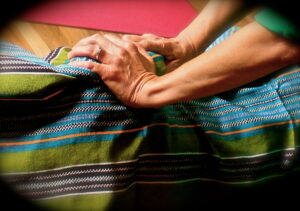
TENS Machine- I used (and still use) the Babycare Elle TENS machine. I can’t say enough about it. I take it to every birth as a doula, and my clients rave about it. It was so awesome also to use it on my lower back and hips at the end of pregnancy, and for afterpains and a stiff shoulders after. During early labour, it made it so I could stay in bed for the contractions. Without it I needed to get up out of bed with each one to process them.
Homeopathic Kit – this kit contains remedies for pregnancy, childbirth, and postpartum in 200c strength. I used a lot of these remedies throughout pregnancy. I used some in labour with my daughter, but there was no need with my son. After my son I used some remedies for perineal healing, swelling, and cracked nipples/breastfeeding concerns.
Preparing pads for the freezer
Having frozen pads prepared is so nice for those first few days when your bottom is a bit swollen (or a lot swollen). I did some of mine with witch hazel, and some with perineal healing wash. With the witch hazel, just open up the pad, pour some on, roll the pad up, and wrap it in plastic wrap or tin foil for the freezer.
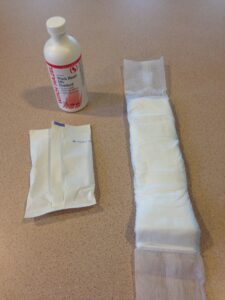
With the perineal healing wash, you will have to brew it first. I recommend making a big pot of it and putting it in the fridge for later. It can be poured into a regular bath, used in a sitz bath, put in the peri bottle, or poured on to pads.
Simply boil some water, add the herbs, let them steep until the liquid is a nice dark brown, and then strain
Water Birth Supplies (unless you’re using your bathtub… then it’s just a bunch of towels)
-TOWELS (honestly, you can’t have too many)
–Tarp or plastic sheets for underneath – also if you do not have carpets I would recommend insulating the ground with a rug or quilt or something. Not only does it make the bottom of the pool even softer, but it also helps with maintaining the water temperature.
–air pump (electric recommended, air mattress strength). Do NOT use an air compressor. Bad things happen when you use those, even if you think you’re being careful.
–faucet adaptor for the hose. If you have a standard tap, simply unscrew the little piece at the bottom of the tap and screw on the faucet adaptor. Now you can screw on your garden hose. If you don’t have a standard tap, you might need to get a bit more creative, depending on what your tap looks like. When we use our birth pool on the porch and run the hose from our kitchen sink, we need to remove the sprayer piece and then just duct tape the hose to the little hose piece that was inside the sprayer. Just make sure that someone is close by to supervise if you’re using duct tape, as it could come undone and make a huge mess.
–CLEAN bucket (for top-ups, and for putting the sub pump into after use for the final drain)
–submersible pump (essential unless you have a lot of time on your hands for a siphon and your home is suitable for that)
–plastic lid or plate or something like that. This is for underneath the submersible pump so it doesn’t suck up the pool liner and cause it to tear.
–shoulder length gloves (optional, but nice)
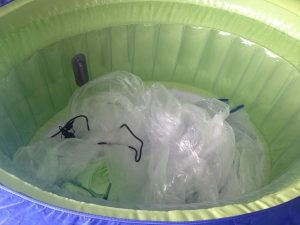
Everything airing out before the big day.
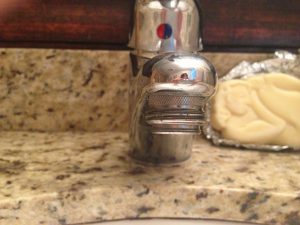
I put the tarp, lid, and liner into the pool to air out before the big day. I chose not to put the liner on the pool yet because I didn’t know how many weeks it would be sitting there and I didn’t want it to collect dust. If you don’t have pets or small children that could possibly puncture the pool, I recommend leaving it blown up. You can always top it up with a bit of air on the big day, and it saves SO much hassle. This way if labour starts suddenly it’s one less thing to worry about.
Draining the Pool:
There are three ways to drain the pool, but only one that I actually recommend.
Option 1: Buckets. It’s like 80 buckets. Your poor back.
Option 2: Siphoning. Expect it to take a pretty long time (like 1 hour+ for a full pool). Submerge the entire hose in the water (a great time to break out the shoulder length gloves!). Plug one end and run it to the exit point and let it go. The exit point needs to be lower than the bottom of the pool. If you live in apartment, or don’t have a lower down garden or something to drain out to, this probably won’t work for you. Also, if the baby was born in this water, it will be gross, so do not put it out a window.
3. Submersible pump: this is what I recommend. It’s the easiest and the fastest. You may need to strain the water with a debris net first. Make sure your submersible pump has a garden hose adaptor. Screw on the hose, and take the other end of the hose to the exit point (I recommend toilet). Put a plastic plate or lid or something under the submersible pump so that it doesn’t suck up the pool liner. Plug in the submersible pump. It should start working almost instantly. Then, just keep your ear perked for any change in the sound. It should be pretty quiet. If it suddenly starts making a loud sucking noise, it means the water level is really low and it’s sucking air. This isn’t great for the pump, so get over there pretty quickly and move the pool around to direct all the water to one end and suck the rest up. When removing the submersible pump, it’s going to drip a lot. I recommend having a bucket handy to transfer it in to.
After any of these methods, remove and throw away the liner. In theory you should have a clean, dry pool underneath. Deflate the pool with the same pump you filled it with (if it has a deflate function), or simply squish all the air out. Fold it carefully for the next use and storage. **make sure the pool is TOTALLY dry before you fold and store it**
Fill a bucket with 1 part bleach to 9 parts water. Soak the submersible pump for a while to disinfect. If there is any visible nastiness on it, wash it off first, as the bleach water probably won’t remove any of that.
Have a great birth!!
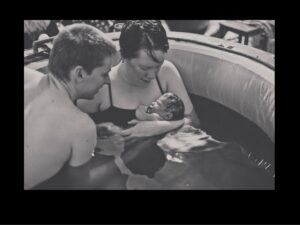

Way cool! Some extremely valid points! I appreciate you writing this post and also the rest of the website is very good. Emmye Nelson Sadoff